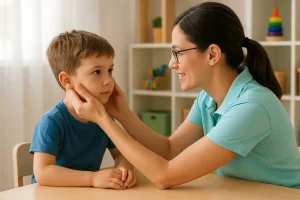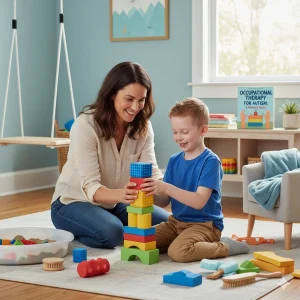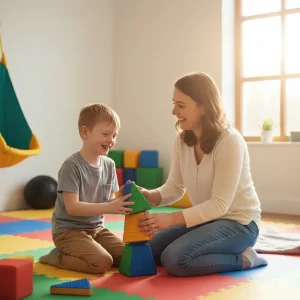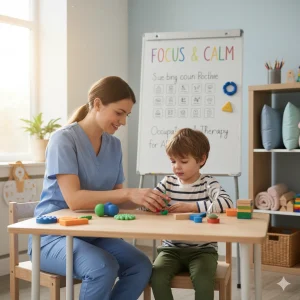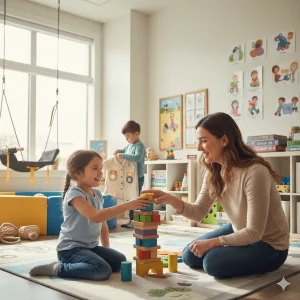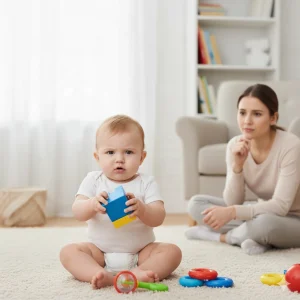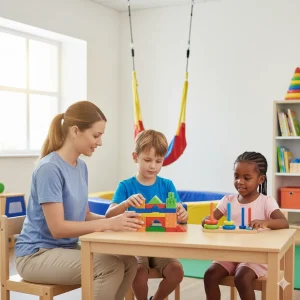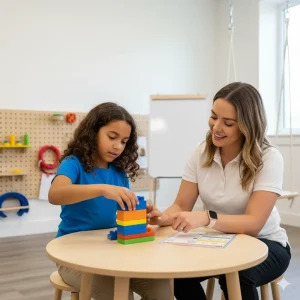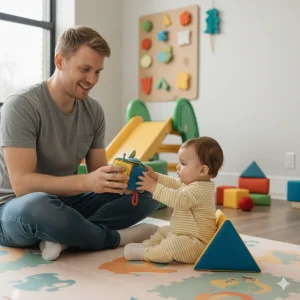Unlocking Potential: A Guide to Pediatric Occupational Therapy
By Prapoorna M
Last Updated: March 4, 2024
Occupational therapy (OT), particularly in the pediatric domain, is an essential service that extends beyond traditional healthcare. It’s not just about treatment; it’s about transforming lives. Think of it as a journey to independence for children who face challenges in their daily activities due to various physical, sensory, or cognitive difficulties.
Imagine a child who struggles with basic tasks like holding a pencil, interacting with peers, or even managing emotions effectively. Pediatric occupational therapy steps in here, offering a beacon of hope. It’s about giving these children the tools and skills they need to navigate their world more effortlessly.
This therapy is pivotal in aiding child development. It’s not just about overcoming the immediate hurdles. It’s about laying a strong foundation for future growth and independence. Through a blend of specialized techniques, children learn to master everyday tasks, improve their school performance, and, most importantly, boost their self-confidence.
Understanding Pediatric Occupational Therapy
Pediatric Occupational Therapy: A Gateway to Enhanced Child Development
At its core, pediatric occupational therapy is a lifeline for children struggling with various developmental challenges. It’s a specialized practice where trained therapists aid young individuals in mastering the essential skills needed for day-to-day living and academic success. The primary goal? To ensure every child can thrive in their unique journey, irrespective of the obstacles they face.
Occupational therapy in the pediatric setting is tailored to the needs of children. It’s not just about overcoming a current difficulty; it’s about equipping children with a toolkit for life. This includes a range of activities and exercises designed to enhance fine motor skills (like writing or tying shoelaces), gross motor skills (such as walking or jumping), cognitive processing, sensory integration, and even social skills.
The Role of Pediatric Occupational Therapists
Pediatric occupational therapists are the architects of this transformation. They are not just therapists; they are allies, cheerleaders, and sometimes, magicians in the eyes of a child. Their role extends far beyond the therapy sessions. These professionals conduct thorough assessments to identify each child’s unique needs and strengths. Then, they craft personalized therapy plans that align with these insights, ensuring that each child gets the support they need in the way they need it.
Through a mix of play, education, and skill development, these therapists create a nurturing environment for children. They work closely not just with the child but also with families, educators, and other healthcare professionals, ensuring a holistic approach to the child’s development.
Also Read: What is the Relation between Communication, Speech and Language? | Speech and Language Therapy
Who Benefits from Pediatric Occupational Therapy?
A Spectrum of Hope: Who Can Benefit?
Pediatric occupational therapy casts a wide net, offering support to a diverse range of children. Whether it’s a toddler with developmental delays, a child grappling with the complexities of Autism or ADHD, or a young one facing sensory processing disorders, OT opens the door to improvement and independence.
Autism:
For children with Autism, OT helps in managing sensory issues, enhancing communication skills, and improving social interactions.
ADHD:
Children with ADHD can benefit from OT by learning how to focus better, organize tasks, and control their impulses.
Sensory Processing Disorders:
OT aids in making sense of the world, helping these children process sensory information more effectively.
Other Conditions:
Beyond these, children with conditions like Cerebral Palsy, Down Syndrome, and even those recovering from injuries or dealing with chronic illnesses can find occupational therapy a valuable ally in their developmental journey.
In every case, pediatric occupational therapy isn’t just about addressing a condition; it’s about unlocking a child’s potential. It’s about guiding them to navigate their world with greater confidence and independence.
Explore more about Autism: For children with Autism, OT helps in managing sensory issues.
Key Services Provided in Pediatric Occupational Therapy
A Spectrum of Therapeutic Techniques for Holistic Child Development
Pediatric occupational therapy is not a one-size-fits-all approach. It encompasses a variety of services, each tailored to meet the unique needs of children. Here, we’ll explore some of the essential services that form the backbone of pediatric OT.
Sensory Integration:
This is pivotal for children who experience sensory processing challenges. Sensory integration therapy helps them make sense of the world around them. It’s about teaching the brain to respond appropriately to light, sound, touch, and other sensory inputs, enhancing a child’s ability to learn and engage with their environment.
Fine and Gross Motor Skills Training:
These are the cornerstones of a child’s physical development. Fine motor skills focus on the small muscles in the hands and fingers – crucial for tasks like writing, buttoning a shirt, or handling utensils. Gross motor skills involve the larger muscles, helping in activities like jumping, running, and maintaining balance. OT assists in refining these skills, paving the way for greater independence and confidence in physical activities.
Cognitive Rehabilitation:
This aspect of OT is all about empowering the mind. It involves exercises and activities that improve cognitive functions such as memory, attention, problem-solving, and executive functioning, which are essential for a child’s academic and social success.
Read more about on What are the therapies offered to Autistic patients? | Therapies of Autism
Advantages of Pediatric Occupational Therapy
Unlocking a World of Possibilities: The Benefits of Pediatric OT
Pediatric occupational therapy is more than just a series of exercises and activities. It’s a journey towards empowerment and independence. Let’s dive into the top ten benefits that make pediatric OT a game-changer in child development.
Enhancing Motor Skills:
Whether it’s fine-tuning fine motor skills for academic tasks like writing or bolstering gross motor skills for physical activities, OT helps children gain mastery over their movements.
Also Read: Motor Developmental Difficulties in Autistic Children | Motor Disabilities due to Autism
Fostering Independence in Daily Living:
Simple tasks like dressing, feeding, and grooming can be challenging for some children. OT teaches these vital skills, promoting independence and self-reliance.
Navigating Sensory Challenges:
For children who find sensory input overwhelming, OT offers strategies to manage and cope with these challenges, leading to better regulation and engagement with their environment.
Building Strength and Stability:
Core strength and stability are crucial for everyday tasks. OT works on these foundational skills, enabling children to navigate their environments more effectively.
Developing Social and Play Skills:
Through occupational therapy, children learn to engage in functional play, understand social cues, and build relationships, enhancing their social interactions and emotional intelligence.
Improving Executive Functioning:
OT addresses crucial cognitive skills like attention, organization, and planning, aiding in better academic performance and daily life management.
Empowering Caregivers and Educators:
Occupational therapy extends its benefits by educating caregivers and teachers, equipping them with strategies to support the child’s development outside of therapy sessions.
Enhancing Visual and Perceptual Skills:
These skills are critical for tasks like reading and writing. OT helps in improving visual-motor and visual-perceptual skills, which are crucial for academic success.
Utilizing Assistive Technology:
Pediatric OT incorporates the use of assistive technology to enhance functional capabilities, ensuring every child can engage in activities to the best of their ability.
Boosting Confidence and Self-Esteem:
Perhaps the most significant benefit of all, OT helps children feel more confident and capable, fostering a positive self-image and a can-do attitude towards life’s challenges.
The Impact of Early Intervention in Pediatric Occupational Therapy
Starting Early: The Power of Timely Intervention
One of the most common questions we encounter is, “When should a child start occupational therapy?” The answer lies in the profound benefits of early intervention. Starting occupational therapy at an early age can significantly enhance a child’s developmental trajectory. It’s about getting in at the ground level and addressing challenges before they become more ingrained.
The Benefits of Early Intervention
- Increased Independence: Early OT helps children develop essential skills for daily living, fostering independence from a younger age.
- Sensory Processing Support: For children with sensory integration issues, early intervention is crucial. It helps them learn to navigate their sensory experiences more effectively, reducing discomfort and enhancing engagement with their surroundings.
- Social and Emotional Development: Early OT can play a pivotal role in helping children develop social skills and emotional regulation, laying the groundwork for healthier social interactions and emotional well-being.
Also Read: Early Identification/ Warning Signs in child development.
Early Intervention in OT: Timeline and Benefits
| Age Range | Developmental Milestones | OT Benefits |
|---|---|---|
| 0-2 Years | Crawling, walking, basic hand-eye coordination, initial speech and social interaction | Enhances motor skill development, supports early communication and social skills, lays the foundation for sensory processing |
| 3-5 Years | Improved motor skills, basic self-care (dressing, feeding), pre-writing skills, more complex speech and social interaction | Refines fine and gross motor skills, promotes independence in daily activities, prepares for school environment |
| 6-8 Years | Advanced motor skills, basic academic skills (reading, writing), developing complex social interactions | Supports academic performance, enhances focus and cognitive skills, fosters social and emotional development |
| 9-12 Years | Mastery of self-care, refined academic skills, complex social, emotional, and behavioral development | Tailors strategies for academic challenges, aids in transition to adolescence, addresses behavioral and social nuances. |
Making Occupational Therapy Work for Your Child
Partnering in Your Child’s OT Journey
As caregivers and parents, your role in your child’s occupational therapy journey is invaluable. Here are some tips to make OT sessions more effective and enjoyable for your child.
Explore more on Tips to Keep Children Engaged in Online Speech Therapy
Prepare Your Child:
Talk to your child about what to expect in OT. Use simple, positive language to describe how the sessions will be like fun activities rather than clinical appointments.
Stay Involved:
Engage in your child’s therapy by understanding the goals and activities. Your involvement can reinforce the skills being learned in therapy, making them a part of daily life.
Create a Supportive Environment:
Ensure that your home environment supports the skills and behaviors encouraged in OT. This might involve setting up specific areas for activities or making adjustments to routines.
Celebrate Small Victories:
Every little achievement in OT is a step forward. Celebrating these can boost your child’s confidence and motivation.
Explore more about on Engaging Home-Based Occupational Therapy Activities for Children with Autism.
Pediatric OT in Different Settings
Adapting to Every Child’s Needs: The Versatility of Pediatric OT Settings
Pediatric occupational therapy is not limited to a single setting; it adapts to meet the needs of children wherever they are. Understanding the various environments in which OT can take place helps in choosing the best option for your child, especially when considering occupational therapy practices for children with special needs.
Hospitals and Clinics:
These traditional settings are equipped with specialized equipment and facilities. They are ideal for children who may require intensive therapy sessions, especially after surgeries or for specific medical conditions.
Schools:
School-based OT is crucial for children who face challenges in academic settings. Here, therapists work directly within the educational environment, helping children with tasks like handwriting, cognitive skills, and social interactions. This integration ensures that therapy is directly aligned with educational goals, making it an effective setting for many children.
Private Clinics:
These offer a more personalized approach, where therapy sessions are tailored to the individual needs of the child. Private clinics often provide a comfortable and focused environment for therapy.
Community Centers:
These settings can be beneficial for social integration and practicing real-life skills in a community environment. They offer a unique opportunity for children to develop social and practical skills in a more naturalistic setting.
Home-Based Therapy:
For children who thrive best in familiar surroundings, home-based OT can be incredibly effective. It allows therapists to work with children in their own environment, making the integration of therapy techniques into daily routines more seamless.
Online Platforms:
The rise of digital technology has made online occupational therapy a feasible and effective option. It’s particularly useful for families living in remote areas or for children who are more comfortable in their home environment. Online OT also offers flexibility in scheduling and access to a wider range of specialists.
Comparison of Pediatric OT Settings
| Setting Type | Benefits | Best For |
|---|---|---|
| Hospital | Access to specialized equipment and medical staff, Intensive therapy sessions | Children with medical conditions requiring close monitoring, Post-surgery rehabilitation |
| School | Integration with educational goals, Convenient for children, Focus on academic and social skills | Children needing support in academic and social aspects, Children who can benefit from therapy in a familiar environment |
| Private Clinic | Personalized attention, Tailored therapy programs, Flexible scheduling | Children requiring specific therapy approaches not available in schools or hospitals, Families preferring a more personalized setting |
| Community Center | Real-life skill development, Social interaction opportunities | Children needing to practice social and community-based skills, Children who benefit from learning in group settings |
| Home-Based | Comfort of familiar surroundings, Easier integration into daily routines | Children with mobility or transportation challenges, Young children or those who respond better in a known environment |
| Online Platform | Convenience and flexibility, Access to a wider range of specialists | Families in remote locations, Children who prefer or need to stay at home, Scheduling challenges |
Conclusion
Occupational therapy helps children develop crucial skills – from basic motor tasks like holding a pencil to managing daily activities such as dressing and eating independently. It also supports children in overcoming sensory challenges and improves their ability to interact socially and emotionally with others.
If you’re considering occupational therapy for your child, remember that it offers a holistic approach to their development. It’s tailored to each child’s unique needs, helping them grow and succeed in their own way. At Wellness Hub, we are committed to supporting families on this journey, providing the guidance and resources needed for your child’s success in occupational therapy.
Frequently Asked Questions
1. What is pediatric occupational therapy?
Pediatric occupational therapy is a specialized field of therapy focused on helping children develop the skills necessary for daily living and school tasks. It addresses challenges in motor skills, sensory processing, cognitive abilities, and social interaction.
2. At what age should a child start occupational therapy?
There’s no set age for starting occupational therapy, as it depends on the individual needs of the child. Early intervention, however, can be particularly beneficial. If you notice developmental delays or difficulties in your child’s ability to perform age-appropriate tasks, it’s advisable to consult an occupational therapist.
3. What conditions can pediatric occupational therapy help with?
Pediatric occupational therapy can assist children with a range of conditions, including Autism Spectrum Disorder, Attention Deficit Hyperactivity Disorder (ADHD), sensory processing disorders, cerebral palsy, developmental delays, and more.
4. How does occupational therapy improve a child’s school performance?
Occupational therapy helps children develop fine motor skills, hand-eye coordination, and cognitive abilities, all of which are essential for tasks like writing, reading, and concentrating in school. It can also help with organizational skills, which are crucial for academic success.
5. Can occupational therapy help with sensory processing issues?
Yes, occupational therapists are trained to help children with sensory processing issues. They use various techniques and activities to assist children in better understanding and responding to sensory information from their environment.
6. Are there different types of occupational therapy for children?
Yes, occupational therapy for children can vary based on their specific needs. It includes sensory integration therapy, fine and gross motor skills training, cognitive rehabilitation, and social skills development. Therapists tailor the approach according to each child’s unique challenges and goals.
7. How can parents support their child’s progress in occupational therapy?
Parents can support their child’s occupational therapy by staying involved in the therapy process, practicing recommended activities at home, creating a supportive home environment, and maintaining open communication with the therapist to monitor progress and provide consistent reinforcement.
8. Is online occupational therapy effective for children?
Online occupational therapy has proven effective for many children, especially when in-person sessions are not feasible. It offers flexibility and convenience while still providing personalized therapy sessions tailored to the child’s needs.
9. How long does a child typically need to attend occupational therapy?
The duration of occupational therapy varies depending on the child’s individual needs, the severity of their challenges, and their progress in therapy. Some children may see improvements in a few months, while others may need ongoing support for longer periods.
10. Where can I find more information about pediatric occupational therapy?
For more information about pediatric occupational therapy, you can visit our website, which offers resources, expert guidance, and support for families considering occupational therapy for their children.
About the Author:
Prapoorna Mangalampalli
M.Sc., M.A., (Dual Masters in Psychology & English) – Counselor (6+ years of experience)
Prapoorna armed with a passionate dedication fueled by dual Master’s degrees in Psychology and English, Prapoorna sheds light on and elevates human experiences. Over 6+ years of experience fuel her insightful approach to counseling, offering profound empathy and guidance across diverse areas like online, marital, relationship, child, family, and career counseling. This dedication to empowering positive change is further underscored by her specialized training in various counseling sectors.
Currently, at Wellness Hub, she thrives in a team environment that values innovation, compassion, and achieving results for their clients.
Connect with Prapoorna to learn more about how she can help you or your loved one find their voice and build a brighter future.
Book your Free Consultation Today
Parent/Caregiver Info:
Client’s Details:
* Error Message
